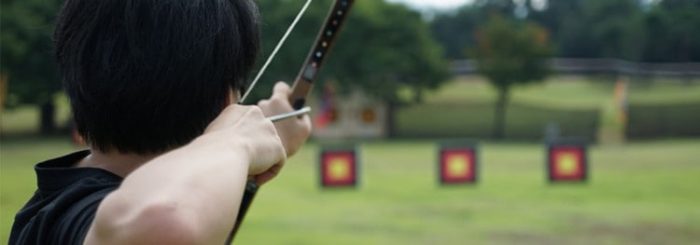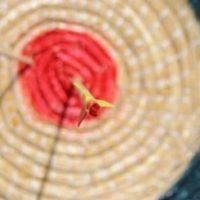Your shooting form is the most important thing to focus on when learning archery. It can make or break your consistency and accuracy – even with the best bow, shooting with improper form will have bad results. Learning proper shooting posture can be complicated and hard, but after practicing for a while it will become almost automatic.
The main things you should focus on with your archery shooting form are positioning your legs correctly, avoiding postural sway, keeping your legs straight but not over-extended, engaging your glutes, avoiding leaning forward, and keeping your back, head, and shoulders in a natural, relaxed position.
In this post, I’m going to detail the essentials of your shooting form. After reading it, you’ll be absolutely ready to start practicing archery and developing the habits of shooting with proper form. We’ll start with the bottom part of your body – your feet and your legs, then continue upwards to your torso, arms, shoulders, and head. Excited? Let’s go.
Feet: types of archery stance
There are a few possible foot positions you can try. Decide which feels most natural to you and stick with it. It’s surprising how foot placement can affect the accuracy of your shooting, but trust me, it’s significant, so pay attention.
There are 3 common archery stances you should know about: squared stance, open stance, and closed stance. The first two are more common than the third, but you should choose the one you’re more comfortable with. Having a correct foot placement is essential for accuracy.

With all types of stance, make sure that your feet are about shoulder-width apart, and that your feet are correctly grounded. You should be completely balanced, so you can perform your shot with a stable base, without leaning in either direction too much. Try to keep your legs relaxed, without putting tension in your knees. Good posture will feel easy to repeat and be consistent with.
Try to test all types of stances and find out which one is most comfortable and natural to you.
- Squared stance: in this position your feet should be in line with the shooting line, meaning you’re side-on to the target. Your front foot (your stronger foot) should be closer to the target. Remember to have your legs at shoulder-width apart, and equally spread the weight between them.
This is probably the most common stance, that every archer learns at the beginning. It’s really natural for many people and easy to learn, which is why it’s recommended for beginners, but it’s also great for more advanced archers. - Open stance: with this one you’ll have your front foot slightly turned to the direction of the target. A good rule of thumb for the angle is about 30 degrees to the shooting line in the direction of the target. Some people find it comfortable to have your other foot in line with the shooting line, others align it with their front foot. Your hips and shoulders will be more open to the target in this stance.
This stance feels really comfortable to many archers – it’s the position most people stand naturally. It’s really balanced and, when done correctly, great for proper muscle engagement. - Closed stance: in this one, you’ll have your back foot turned away from the targets, and your front foot aligned with the shooting line. You’ll basically mirror the open stance. By turning your torso towards the target, you’ll be able to aim and shoot.
Though less common than the previous stances, many archers find that they can put much more force into their shots with this one. You’ll have much more tension in your muscles, which will also create stability.
How to find your ideal shooting stance
A good method of finding your ideal shooting stance is using the “blind shooting” method. To do that, you’ll need to locate a range with a target in the middle of a target wall and get the help of a friend.
Position yourself in front of the target, with the stance you want to check. Close your eyes and turn your head away from the target, without moving your feet, and while keeping your bow pointed in a safe direction. Keep your eyes closed, turn back to the target and draw your bow to the correct shooting position. Have your buddy make sure you’re safely shooting at the wall, and release the arrow.
Now see where your arrow landed relative to the target. Depending on where it was located, move your legs and try to find your centered position. Try this process a few times until you consistently hit around the target. When you do – you found your preferred position.
Finding your ideal shooting stance is important because shooting in a different stance might decrease your accuracy. For example, I’ve mentioned stance as a major cause of arrows going off to the side, and arrows going low in recent articles. While there are other causes, which are detailed in the posts, the stance is definitely a common one.
Notice your postural sway
Postural sway is a leaning of the entire body when on full draw. By watching the shooter from behind, you can notice the whole body moves forward like they’re being pushed.
This movement is usually managed by fixing your lower body stance. The more stable you are when on full draw, the easier it will be to remain still in the correct position. You can check if you sway by filming yourself from behind with your phone, or simply by asking a friend to watch you from the back. The goal should be to remain in place until after your arrow hits the target.
If you sway a lot, consider re-checking your stance and strengthening your core. The more still you’re able to stay, the better your aim will eventually be.
Legs, glutes, and pelvis
An extension of your feet, that helps to maintain balance and stability, are your legs, glutes, and pelvis. Keeping good posture in your legs is essential for accuracy.
Your legs should be straight, but without locking your knee and overextending the quads. You should aim to “push out” with the legs muscles, to avoid inwards collapsing the knees. This means your glutes should be tight. Your pelvis should be positioned directly in the center of your body, without your bum sticking out.
The basic thing you need to notice about your legs is that they’re straight but not overextended. This means you don’t lock your knees, but don’t bend them as well. This means your quads shouldn’t feel very tense, and that the position should feel natural and relaxed.
Another thing you should focus on is pushing out with your legs. This would feel like you’re trying to push your heels together, but without moving your feet at all. This will make you much more stable and will avoid your knees collapsing inwards, which causes instability.
By pushing out with your legs, you’ll feel your glutes engaging. This essentially means your bum is tight and squeezed. This will help with increasing your stability and overall form.
Regarding your pelvis, you should aim to keep it in the center of your body. Engaging your glutes will be the first step because your bum can’t stick out when your glutes are tight. You should feel that your pelvis is tilted forward. This will ensure that your back isn’t arched and will promote good posture.
Obviously keeping your legs, glutes and pelvis contribute and compliment each other. Keep one in a proper position will make it much more likely that the others are also correct.
Torso
This area is where many archers make mistakes, that cost them all around in their shot accuracy. Just like other parts of your body, inconsistent torso posture will eventually lead to inconsistent shots, which will cause worse groupings. Having a proper torso position will make it much easier to have better results.
The main thing you should notice about the position of your torso is that it’s straight-up. You shouldn’t be leaning forwards or backward, or be bent left or right. Your core should be engaged, but you shouldn’t puff your chest out – simply try to stand naturally.
The main thing you should notice when considering your torso is that you’re not leaning. The position of your torso affects how you perform your shot and which muscles are being engaged as a part of the movement. An incorrect torso position can mess you shot up, while the bad habits of improper form can facilitate the development of back imbalances.
Try to relax, and not lean into the bow or away from it. Also, notice that don’t bend left or right, because it will compromise the way your weight is spread. Your position should be straight up.
While shooting, try to keep your core engaged, to improve your stability. The area below your belly button should feel a bit tense while you’re performing a shot. Maintain the core engagement throughout the shot, from the moment you stand on the line until your arrow hits the target.
If you’re having a hard time correcting your torso posture, you should check if your bow actually fits you. Having a draw length set too high or too low can make you lean in either direction and ruin your overall stance. If you think you’re suffering from this issue, I’ve detailed exactly how to check if your bow’s draw length fits you in a previous post, which you should check out.
Shoulders
While it’s quite easy to keep the drawing hand’s shoulder in its proper location, many archers make mistakes with the bow arm’s shoulder. Shrugging it up or overextending it can cause inconsistencies in your shots and compromise your accuracy.
Your front shoulder should be relaxed, so try to keep it in a natural position without pulling it up or down. Your back shoulder will typically naturally come to the correct position if your arms are properly placed, without much thought. The lower part of your shoulder blades will feel engaged in this position.
An issue some archers come into is rounding of the shoulders. This is usually caused by an incorrect posture that is built in our day-to-day life. You basically drop your chest too much, which causes your shoulders to round and your upper shoulder muscles to tense up. This can be really uncomfortable. If you have this issue, try to focus on keeping your chest in a natural position, and your shoulders will fall into place.
Just like I detailed in the previous section, an incorrect draw length can cause issues with the position of your shoulders. A long draw length will usually cause your shoulders to overextend. If you think you might suffer from this issue, read my post about measuring your draw length.
Head
The positioning of your head is mainly important for your comfort. It’s still important for your consistency that you find the proper head position for yourself. Note that with different bows, you might want to change up the positioning of your head, because the technique is a bit different. Trial and error will be the best way to go about finding your ideal head positioning.
There are a few guidelines for your head positioning I think you might find useful. Since you’re going to keep your head static throughout the shot, you should find a position that is comfortable for you, meaning your neck muscles should be completely relaxed. Your head should be a bit elevated above the horizon, and you might find it more comfortable to angle it a bit to the side.
The most important thing about the position of your head is that you’re able to clearly see the target, stay static for the entire shot process and that you can easily and consistently anchor. A common anchor point is the bowstring to the nose position. In this position, the drawing hand will touch your jawbone, while the bowstring will touch the tip of your nose. It’s really accurate and easy to perform, especially if you follow the guidelines I detailed here and keep a proper head posture.
Grip
Your grip is the main contact you have with the bow, which is why it’s so important that you take time to make sure it’s correct. Bad grip causes inconsistent shooting and lowers your overall accuracy.
The main thing you should notice about your grip is that your hand is properly positioned and oriented. The part of your palm that should have contact with the bow is the meaty part, right under your thumb. You want to hold the bow lightly, without putting pressure with your fingers – they’re just there to make sure your grip is stable. The draw pressure will keep the bow in place.
There’s a simple process to perform a correct grip, that you can follow to make using correct form easier:
- Make an “L” with your holding hand. This means you hold your thumb and index finger in 90 degrees to each other. The other fingers will remain bent.
- Place your hand on the bow’s grip location. Don’t change the position of the hand, and let it naturally slide to the correct position. The bow should rest on the meaty part of your palm, under your thumb.
- Use your drawing hand to start pulling the bowstring. Notice that this will load pressure to your holding hand, which will allow you to let your fingers rest.
- You can now relax your fingers. You don’t have to though – do whatever feels natural to you. Make sure you’re not grabbing the bow, and that your fingers are just resting, even if you decide to keep them bent.
- Make sure you’re not applying torque to the bow. If you do, it’s usually because you’re applying pressure and holding the bow with your holding hand. Your wrist should sit in a natural position, without you having to bend it in any direction.
If you follow these steps, it will be easy to keep a correct grip on your bow.
Conclusions
There is much to say about proper archery form. In this post, I tried to convey how important it is that you make sure your posture is correct and that you’re doing everything strictly. Improving your archer form is the main, best way to start getting higher shooting scores when starting out, and it’s so important to develop good habits from the get-go.
I hope you’ve learned something new from this post, and that it gave you ideas of things to notice on your next archery practice. Try to find one or two things to focus on the next you’re training. I’m sure that with the knowledge here you’ll be able to perfect your form in no time.



